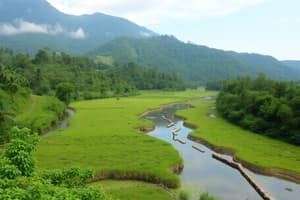Podcast
Questions and Answers
What main aspect does environmental science focus on?
What main aspect does environmental science focus on?
- The study of economic policies and their impacts
- Interconnected natural systems and human influences (correct)
- The analysis of historical events related to human activities
- The historical evolution of scientific methods
Which of the following components are included in the study of both living and nonliving systems?
Which of the following components are included in the study of both living and nonliving systems?
- Water, minerals, and social constructs
- Nonhuman species and economic systems
- Humans and cities
- Air, plants, and energy sources (correct)
How does human activity influence the environment according to the overview?
How does human activity influence the environment according to the overview?
- By solely relying on renewable energy resources
- By adding greenhouse gases to the atmosphere (correct)
- By minimizing air pollution through regulations
- By preserving ecosystems without intervention
What role does biodiversity play in environmental science?
What role does biodiversity play in environmental science?
What is one of the key focuses of section II in the study of environmental science?
What is one of the key focuses of section II in the study of environmental science?
What is a significant issue that environmental science seeks to address?
What is a significant issue that environmental science seeks to address?
Which topic is NOT covered in section IV of the content?
Which topic is NOT covered in section IV of the content?
What do environmental scientists develop strategies for, according to the content?
What do environmental scientists develop strategies for, according to the content?
What is a major challenge in assessing environmental impacts of human actions?
What is a major challenge in assessing environmental impacts of human actions?
How do scientists generally measure energy?
How do scientists generally measure energy?
Which of the following is an example of inconsistent energy measurement units?
Which of the following is an example of inconsistent energy measurement units?
What complicates the choice between using paper bags and plastic bags?
What complicates the choice between using paper bags and plastic bags?
What substance is noted for potentially posing more risk to people due to its use in plastic bag production?
What substance is noted for potentially posing more risk to people due to its use in plastic bag production?
Which element in the environment is difficult to measure consistently due to various units?
Which element in the environment is difficult to measure consistently due to various units?
What historical evidence is cited to show human impact on the Earth?
What historical evidence is cited to show human impact on the Earth?
Why is it challenging to determine which bag type, paper or plastic, is environmentally superior?
Why is it challenging to determine which bag type, paper or plastic, is environmentally superior?
What does a steady state system indicate about inputs and outputs?
What does a steady state system indicate about inputs and outputs?
In the example of the bucket with holes, what is the net flux if the input and output are both 1 liter per minute?
In the example of the bucket with holes, what is the net flux if the input and output are both 1 liter per minute?
Which method can be used to determine the size of a pool in a steady state analysis?
Which method can be used to determine the size of a pool in a steady state analysis?
What happens when one of the fluxes in a steady state system is altered?
What happens when one of the fluxes in a steady state system is altered?
Why is it important to determine if a system is in steady state when conducting balance analyses?
Why is it important to determine if a system is in steady state when conducting balance analyses?
Which example illustrates a natural system that is often in steady state?
Which example illustrates a natural system that is often in steady state?
What must be monitored to maintain steady state in a controlled reservoir?
What must be monitored to maintain steady state in a controlled reservoir?
If inputs exceed outputs in a system, what is the likely consequence?
If inputs exceed outputs in a system, what is the likely consequence?
What was the significant outcome of the California Supreme Court's ruling in 1983 regarding Mono Lake?
What was the significant outcome of the California Supreme Court's ruling in 1983 regarding Mono Lake?
Which factor contributed to the increase in Mono Lake’s water level in 2023?
Which factor contributed to the increase in Mono Lake’s water level in 2023?
How is mean residence time (MRT) calculated?
How is mean residence time (MRT) calculated?
What does a mean residence time (MRT) of 10 minutes indicate?
What does a mean residence time (MRT) of 10 minutes indicate?
What ultimately proved to be the solution to preventing the death of Mono Lake?
What ultimately proved to be the solution to preventing the death of Mono Lake?
What does steady state refer to in the context of the mean residence time (MRT)?
What does steady state refer to in the context of the mean residence time (MRT)?
Which of the following statements about the Mono Lake case is true?
Which of the following statements about the Mono Lake case is true?
What is the importance of understanding input-output system dynamics in environmental problems?
What is the importance of understanding input-output system dynamics in environmental problems?
What is an example of a negative feedback loop?
What is an example of a negative feedback loop?
What characterizes a positive feedback loop?
What characterizes a positive feedback loop?
How does evaporation relate to Earth's heating system feedback loop?
How does evaporation relate to Earth's heating system feedback loop?
What might result from greater cloud cover due to evaporation?
What might result from greater cloud cover due to evaporation?
What happens to a negative feedback loop when conflicting factors occur?
What happens to a negative feedback loop when conflicting factors occur?
Which scenario is a vicious cycle indicative of a positive feedback loop?
Which scenario is a vicious cycle indicative of a positive feedback loop?
What is the consequence of warmer temperatures leading to increased evaporation?
What is the consequence of warmer temperatures leading to increased evaporation?
What distinguishes the starting point of a system variable in negative feedback?
What distinguishes the starting point of a system variable in negative feedback?
What does mean residence time (MRT) indicate for a substance dissolved in water?
What does mean residence time (MRT) indicate for a substance dissolved in water?
Which gas has the longest estimated residence time in the atmosphere?
Which gas has the longest estimated residence time in the atmosphere?
Why is the estimated residence time for carbon dioxide considered rough?
Why is the estimated residence time for carbon dioxide considered rough?
What is one potential effect of warmer temperatures on environmental dynamics?
What is one potential effect of warmer temperatures on environmental dynamics?
What does steady state imply regarding mean residence time?
What does steady state imply regarding mean residence time?
What occurs in a positive feedback loop related to climate change?
What occurs in a positive feedback loop related to climate change?
Which of the following pollutants has a residence time of approximately 11.8 years?
Which of the following pollutants has a residence time of approximately 11.8 years?
What implication does the presence of heat-trapping gases have for the Earth's climate?
What implication does the presence of heat-trapping gases have for the Earth's climate?
Flashcards
Environmental Science
Environmental Science
The study of how living organisms interact with their non-living surroundings, focusing on how human activities impact these interactions.
Earth Systems
Earth Systems
Interconnected networks of living and nonliving components that exchange energy and matter.
Biodiversity
Biodiversity
The variety of life on Earth, encompassing genes, species, and ecosystems.
Ecosystem Ecology
Ecosystem Ecology
Signup and view all the flashcards
Global Climate Change
Global Climate Change
Signup and view all the flashcards
Sustainable Earth
Sustainable Earth
Signup and view all the flashcards
Atmospheric Science
Atmospheric Science
Signup and view all the flashcards
Steady State System
Steady State System
Signup and view all the flashcards
Input
Input
Signup and view all the flashcards
Output
Output
Signup and view all the flashcards
Net Flux
Net Flux
Signup and view all the flashcards
Pool Size
Pool Size
Signup and view all the flashcards
Mass Balance
Mass Balance
Signup and view all the flashcards
Energy Balance
Energy Balance
Signup and view all the flashcards
Monetary Balance
Monetary Balance
Signup and view all the flashcards
Original State of Earth?
Original State of Earth?
Signup and view all the flashcards
Lead in Greenland Ice
Lead in Greenland Ice
Signup and view all the flashcards
Inconsistent Energy Units
Inconsistent Energy Units
Signup and view all the flashcards
Subjectivity in Environmental Choices
Subjectivity in Environmental Choices
Signup and view all the flashcards
Value Judgments & Environmental Choices
Value Judgments & Environmental Choices
Signup and view all the flashcards
PCB in Penguins
PCB in Penguins
Signup and view all the flashcards
Species Introduced to Remote Islands
Species Introduced to Remote Islands
Signup and view all the flashcards
Complexity of Environmental Impact
Complexity of Environmental Impact
Signup and view all the flashcards
Mean Residence Time (MRT)
Mean Residence Time (MRT)
Signup and view all the flashcards
Steady State
Steady State
Signup and view all the flashcards
Pool
Pool
Signup and view all the flashcards
Flux
Flux
Signup and view all the flashcards
Input-Output System
Input-Output System
Signup and view all the flashcards
Calculating MRT
Calculating MRT
Signup and view all the flashcards
Mono Lake Example
Mono Lake Example
Signup and view all the flashcards
MRT & Environmental Health
MRT & Environmental Health
Signup and view all the flashcards
Feedback
Feedback
Signup and view all the flashcards
Negative Feedback Loop
Negative Feedback Loop
Signup and view all the flashcards
Positive Feedback Loop
Positive Feedback Loop
Signup and view all the flashcards
Earth's Heating System Feedback Loop
Earth's Heating System Feedback Loop
Signup and view all the flashcards
Reflected Sunlight
Reflected Sunlight
Signup and view all the flashcards
Conflicting Factors
Conflicting Factors
Signup and view all the flashcards
Set Point
Set Point
Signup and view all the flashcards
Global Carbon Cycle
Global Carbon Cycle
Signup and view all the flashcards
Accumulation/Depletion
Accumulation/Depletion
Signup and view all the flashcards
Greenhouse Gas
Greenhouse Gas
Signup and view all the flashcards
Evaporation
Evaporation
Signup and view all the flashcards
Study Notes
Introduction
- Environmental science studies the impact of human activities on the environment
- Pollution, biodiversity loss, and climate change are examples of these impacts
- Environmental science is interdisciplinary, involving many fields of study
- Includes biology, earth and atmospheric science, chemistry, physics, and human population dynamics
- Environmental science uses the scientific method to explore environmental issues
- Examines how interconnected systems, which include living and non-living parts interact
Section I: Foundations of Environmental Science
- Environmental science is the study of environmental systems
- Environment includes living and non-living components, such as predators, prey, weather, resources, and landscape
- Environmental indicators measure environmental health
- Global temperatures, atmospheric CO₂, human population, and species diversity are critical environmental indicators
Section II: Biodiversity: From Local to Global
- Biodiversity describes the variety of Earth's organisms
- Includes genetic variety, species variety, ecosystem variety
- Genetic diversity is the variety of genes which determine characteristics
- Species diversity is the variety of species in a community or ecosystem
- Ecosystem diversity is the variation in the different types of biological communities
Section III: The Human Impact on Natural Resources
- Human population growth is a key environmental concern
- Factors influencing population growth include birth rate, death rate, immigration, emigration, etc
- Population size influences resource use with higher populations using more resources
- Differences in population growth rates exist between different countries
- Age structure of a population can be significant for predicting growth rates and associated resources needs.
Section IV: Science for a Sustainable Future
- Air pollution is caused by human and natural factors
- Air pollution impacts human health and the environment
- Major air pollutants include sulfur dioxide, nitrogen oxides, and particulate matter
- The atmosphere's composition affects a region's climate and weather patterns
- Greenhouse gases are a significant concern due to human impact
- Renewable energy sources and energy conservation strategies are crucial for a sustainable future
Studying That Suits You
Use AI to generate personalized quizzes and flashcards to suit your learning preferences.



